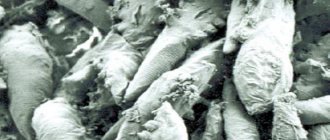Lymphoma in dogs is an oncological disease that affects not only people, but also pets. Often it begins asymptomatically, so the time when treatment can still help a little is missed. There are many types of lymphoma, and an accurate diagnosis can only be made in a veterinary clinic after a series of studies.
Causes of the disease
The exact cause of lymphoma has not been found. Veterinarians note a hereditary predisposition. The theory that the appearance of lymphosarcoma is influenced by long-term use of corticosteroids has not been proven. The viral nature of the disease and exposure to radioactive elements are controversial. Viruses can cause cancer in cats. Not proven in dogs.
Scientists suggest that the cause of cancer may be external influences on dogs. This is the use of herbicides and fertilizers on the site. Or the animal lives near a plant that emits harmful substances. If a home is being renovated, a large amount of paint and varnish is used. Volatile substances contain carcinogens and have a detrimental effect on the body.
A weakened immune system is a trigger for the onset of lymphoma.
Treatment of pathology
Lymphoma in young children is considered an incurable disease. Treatment is aimed at achieving stable remission. Chemotherapy and radiation therapy are used for this purpose. Antitumor drugs such as:
- "Cyclophosphamide";
- "Fluorouracil";
- "Doxorubicin";
- "Hydroxyurea."
In severe cases, a bone marrow transplant is used. This procedure is aimed at improving the health of lymphocytes formed in the spinal cord.
Main symptoms
Symptoms of lymphoma are completely different, depending on the type of disease. No two sick animals have the same signs.
Based on the type of progression, lymphosarcoma is divided into:
- multi-pole;
- gastrointestinal (alimentary);
- mediastinal;
- cutaneous;
- spinal (spinal cord is affected).
The most common is multipolar, when all lymph nodes are affected. Superficial ones are more susceptible. Cancer spreads to neighboring organs. Dysfunction occurs, which is why the pet dies.
If the kidneys are affected, the blood stops being cleansed as it should. Death occurs from intoxication of the body.
The cutaneous type of lymphoma is characterized by the formation of compactions. They are located under the skin. They grow and become painful. These are subcutaneous lymph nodes affected by cancer. Weeping ulcers form and do not heal for a long time.
Signs do not appear for a long time; this is a hidden form. They also appear blurry. There are no specific symptoms. Anorexia, shortness of breath, and ascites (accumulation of fluid in the abdominal cavity) occur. There is constant thirst, frequent urination, anemia, and fever.
With the mediastinal type, cyanosis of the mucous membranes, cough, and shortness of breath are observed. This occurs due to the release of fluid in the pleural cavity.
With the gastrointestinal type, weight loss, vomiting, and diarrhea occur. Palpating the abdomen reveals intestinal compaction and an enlarged spleen.
The spinal form is characterized by damage to the bone marrow. Then the hematopoietic system produces cancer cells instead of normal ones. This type occurs at stages 4-5.
Lymphoma of dogs
Oncologist, specialist in oncosurgery and chemotherapy
Fomicheva Daria Vladimirovna
If a patient cannot be cured, this does not mean that he cannot be helped...
Hospice Assistance Fund "Vera"
Lymphomas (lymphosarcoma)
is a group of malignant diseases that primarily affect the lymphatic system, which, being an important part of the immune system, plays a major role in protecting the body against infections.
In lymphoma, immune system cells degenerate into abnormal, “tumor” lymphocytes. These lymphocytes, instead of protecting the body, begin to populate the lymph nodes, various internal organs, and then the bone marrow, which leads to disruption of the functioning of these organs.
The concept of “lymphoma” unites more than 30 diseases, different in their clinical manifestations, course and prognosis. The most common form of lymphoma in dogs is one that affects the lymph nodes. This form is called multicentric, it is an analogue of non-Hodgkin lymphoma in humans. Less common types of lymphomas involve the gastrointestinal tract, mediastinum, kidneys, central nervous system, heart, and eyes.
The causes of lymphoma in dogs are unknown.
Symptoms of the disease
When a dog develops multicentric lymphoma, usually the first thing owners notice is a sudden increase in the size of the superficial lymph nodes, such as those in the neck. Unlike infectious diseases, with lymphoma the size of the lymph nodes does not decrease over time or with antibiotic treatment. The general condition, as a rule, remains normal, but symptoms such as weakness, fever, weight loss, diarrhea, vomiting may occur, and blindness may also develop.
With other localizations of lymphoma, for example, in the organs of the chest cavity or gastrointestinal tract, there may be symptoms of dysfunction of the corresponding organ (shortness of breath, cough, diarrhea, constipation, progressive thinness for no apparent reason, and much more).
There are several places on a dog's body where swollen lymph nodes can be noticed. If you notice round, dense, mobile, painless formations on your dog’s body in one of these places or in several, this is a reason to immediately consult a doctor!
Diagnostics
An examination by a doctor can reveal clinical symptoms characteristic of lymphoma. If lymphoma is suspected, the doctor performs a biopsy, that is, takes a certain amount of biological material from the affected organ (most often from the lymph node) for morphological examination. To further diagnose the patient’s condition, clinical and biochemical blood tests are also performed.
Morphological examination is the main method to confirm or refute the diagnosis of lymphoma. The study is carried out by a pathologist who processes the biological material taken from the animal in a special way and then examines it under a microscope. The doctor’s task is to determine whether a given biological material contains tumor (lymphoma) cells. The biological material can be a fragment of tissue (the study in this case is called histological) or simply a certain number of cells (cytological study). The advantage of a cytological examination is that it is easier to obtain biological material (no surgery is required), but a histological examination can give a more reliable result.
In medical practice, it is customary to always conduct a histological examination, for which the affected lymph node or part of it is removed during surgery.
In veterinary medicine, a puncture (puncture) of the lymph node is often performed and the collected material (puncture) containing cells is sent for cytological examination. The puncture is performed using a syringe; no anesthesia or anesthesia is required. This method is widely used due to its simplicity, relatively low cost, fairly quick results (in our clinic - within a week at most) and high reliability for typical clinical symptoms.
In doubtful cases, the lymph node is removed for histological examination. This procedure is a minor operation and is performed under general anesthesia. There is also a method of taking material for histological examination without anesthesia, using a special biopsy needle, however, this method is still rarely used in veterinary medicine due to the high cost of biopsy needles.
After confirming the diagnosis, additional studies are required to establish the stage of the process - chest X-rays, ultrasound examination of the abdominal cavity, and sometimes - collection of material for the study of red bone marrow.
Treatment
Unfortunately, to date, lymphoma in animals is incurable and inevitably leads to death. However, we can provide treatment that aims to increase the patient's life expectancy and improve its quality.
The main treatment for canine lymphoma is chemotherapy. With the help of chemotherapy, it is usually possible to achieve remission of the disease lasting 6-8 months. The average life expectancy with chemotherapy is 9-12 months.
Chemotherapy consists of administering cytostatics (drugs that suppress the growth of tumor cells), such as cyclophosphamide, vincristine, doxorubicin, as well as additional drugs, such as prednisolone. However, cytostatics not only suppress tumor growth, but also damage almost all normal tissues of the body. First of all, the rapidly renewing cells of the digestive tract, bone marrow, and hair follicles are affected. Therefore, during chemotherapy, complications caused by cytostatics must be treated.
The choice of treatment program (set of drugs, frequency and mode of administration) depends on the type of lymphoma and the patient’s condition. The question of the number of courses required for stable remission is the most difficult; there is still no consensus on this among veterinary oncologists. The problem lies in the so-called “drug resistance,” which develops in tumor cells after treatment is stopped. It turns out that when the disease returns, and this always happens with lymphoma, the drugs that we used at the first stage are no longer able to suppress tumor growth, and we have to select others.
Treatment for complications of chemotherapy is also varied and depends on the degree of their manifestations in each individual patient. For some, it is the prescription of appropriate medications in tablets, for others, it is treatment in the intensive care unit (hospital).
After a chemotherapy session, the patient spends most of the time at home. It is periodically necessary to bring the patient to the doctor for examination and take blood tests to monitor the condition. Effective patient management requires mutual understanding between the owner and the doctor, since most of the patient's monitoring falls on the owner.
When a patient with lymphoma is in poor condition, treatment with prednisone alone is sometimes used. However, it must be remembered that the use of prednisone without chemotherapy can improve the animal's condition, but will not prolong its life. The average life expectancy with this treatment is 1-2 months.
When diagnosed with lymphoma, of course, we cannot cure our patient, but we can try to prolong his life by at least a few months. Of course, by human standards, this is not much, but it is still better than if these months of life did not exist at all...
An oncological diagnosis is always a big challenge for both the animal and its owner. We will do everything in our power to help your four-legged friend and support you in difficult times! Our clinic employs several oncologists from different fields, which allows our center to provide competent assistance in the diagnosis and treatment of cancer in your pets. We have knowledge, experience, as well as all the necessary equipment - x-rays, ultrasound, equipment for performing biopsies. Having your own oncologist-pathologist allows you to quickly make a diagnosis. Large operating room and experienced surgeons - successfully perform a biopsy. And oncologists-chemotherapists are responsible for administering chemotherapy correctly and ensuring that side effects are minimal.
Diagnostics in a veterinary clinic
If clinical signs of illness are detected in a dog, the owner must immediately take the pet to a veterinarian. In addition to examining and palpating all internal organs, many tests are prescribed. Ultrasound of organs that cannot be palpated. Radiography. All superficial lymph nodes are examined.
A blood test that looks at the number of leukocytes. An alarming factor is considered to be immature red blood cells in the blood, increased protein. Based on this, a serological blood test is performed.
They take urine for analysis. Cytological examination of the affected organ, when a tissue sample is taken. With the help of this study, a final diagnosis is made.
Diagnostics
Diagnosis of lymphoma in dogs is a multi-stage and complex process and is carried out according to a proven algorithm. The first stage is a clinical examination of the animal, during which the doctor determines the enlargement of the superficial lymph nodes, their mobility and pain on palpation. At the next stage, an ultrasound examination of the lymph nodes and abdominal organs is performed to determine the presence of changes in the liver and spleen. An X-ray of the chest organs is taken to identify enlarged lymph nodes and changes in the lungs. Blood tests are done, including determining the level of lactate dehydrogenase, an important marker of tumor activity in lymphomas. In complex or doubtful cases, magnetic resonance or computed tomography is performed. This type of study is not routine, as it involves general anesthesia for the patient and is financially expensive.
Treatment method and prognosis
The prognosis of the disease depends on the stage of lymphoma. Secondary signs, damage to internal organs, and general intoxication are taken into account. The condition of the dog is determined by the condition of the liver and spleen. They look at the stage of enlargement, formation of nodes, and alkaline phosphatase levels in the blood serum. Based on these indicators, a prognosis of the disease is made.
Without treatment, a dog lives a maximum of 2–3 months after diagnosis. But lymphoma is an incurable disease. You can only support and prolong the life of your pet. Chemotherapy, radiation therapy and surgery are used for this. If the disease is detected at an early stage, there is a chance to get a stable and long-term remission. Timely treatment can stop the disease.
Chemotherapy uses chemotherapy drugs. Lymphoma cannot be cured with one drug; two or three are combined at once. But if the dog is severely intoxicated and there is a risk of severe side effects, then one drug is used. The medicine is selected depending on the toxic effects.
In combination treatment, L-Asparaginase and nitrosourea preparations are used.
Radiation therapy is used at stages 1–2. In combination with chemotherapy.
Surgery is performed if a large number of cancerous tumors form. Also in case of conditions that interfere with the normal life of the dog, such as intestinal obstruction, blood loss, and if the tumor puts pressure on neighboring organs or vessels.
Prognosis for lymphoma in dogs
The prognosis for all types of lymphoma in dogs is cautious; it depends, first of all, on the type of tumor itself. Thus, with small cell B-cell lymphoma, the average life expectancy of patients during chemotherapy treatment is 24 - 36 months. With large cell T-cell or NK-cell lymphoma, the average life expectancy, even with aggressive chemotherapy, does not exceed 8 months.
Therefore, when a diagnosis such as lymphoma is confirmed, it is necessary to urgently consult with an oncologist about the prognosis and development of a treatment regimen.
We express our deep gratitude to Litvinov N.V. and Azarova M.S. for assistance in preparing the article.
What to do at home
The owner of the dog must monitor its health. If symptoms are detected, see a veterinarian. Monitor whether tests have been done and examinations have been carried out. The doctor may prescribe treatment that can be done at home.
The dog is provided with good living conditions. Strict diet, feeding by the hour. Provide drinking water.
It is important to understand that lymphoma is incurable. Even in the early stages there is no guarantee of a complete cure. The owner must understand this and prepare for the possible death of the pet. No matter how sad it may sound.
Diagnostics and therapy
The most important thing is the biopsy. Firstly, it will make it possible to accurately determine that the neoplasm detected on the dog’s body is, in fact, lymphosarcoma. Secondly, a biopsy will distinguish it from simple inflammation of the lymph nodes. A complete blood count, serology and biochemistry are also important steps. Firstly, this way you can understand whether the animal is suffering from any infectious diseases that can give similar symptoms. Secondly, all these tests will allow the veterinarian to find out what condition the animal is in at the time of treatment.
Possible complications
Lymphoma is divided into five stages. On the first and second, one or more lymph nodes are affected, the animal’s condition is normal. There may be no signs. The third is characterized by spread to all lymph nodes. The fourth involves damage to the spleen and enlargement of the liver. On the fifth, the bone marrow and nervous system are affected.
Depending on the stage, complications are mentioned. At the third stage, in addition to the lymph nodes, nearby organs are already affected. Kidneys, bladder, lungs, heart, etc. Then the functions of these organs weaken and stop working. This condition most often leads to death.
Types, forms and stages of lymphoma
There are 2 types of pathology:
- Hodgkin's lymphoma (lymphogranulomatosis). It is detected in children older than 5–6 years. Hodgkin's lymphoma develops slowly and is easy to treat.
- Non-Hodgkin's lymphoma. Diagnosed in children from the age of 3. It is characterized by rapid development and difficult treatment.
Along with this, there are such forms of the disease as:
- nodular;
- with a high level of lymphocytes;
- with an increased number of leukocytes;
- with a low white blood cell count;
- mixed-cellular.
In addition, there are 4 stages of the disease:
- first - one area of localization of lymph nodes, a single immune or extra-lymphatic organ is affected;
- second - the tumor spreads to the lymph nodes located to the left or right of the diaphragm, or to one of the extra-lymphatic organs;
- third - the lymph nodes located on both sides of the diaphragm are affected;
- fourth - an extralymphatic organ is affected with the formation of multiple foci.
Prognosis, consequences and complications
If measures are taken in a timely manner, in 95 out of 100 cases the prognosis for recovery is favorable. The duration of therapy is no more than 5 years. During this time, the affected organs and systems are completely restored.
Ignoring the symptoms of the disease or delaying treatment of lymphoma can lead to the development of the following consequences:
- cancer of the spinal cord and brain, as well as cancer of other organs;
- pathologies of the respiratory system;
- sepsis;
- death of a child.
Source of the article: https://rosmedplus.ru/bolezni/onkologiya/limfoma-u-detej.html











